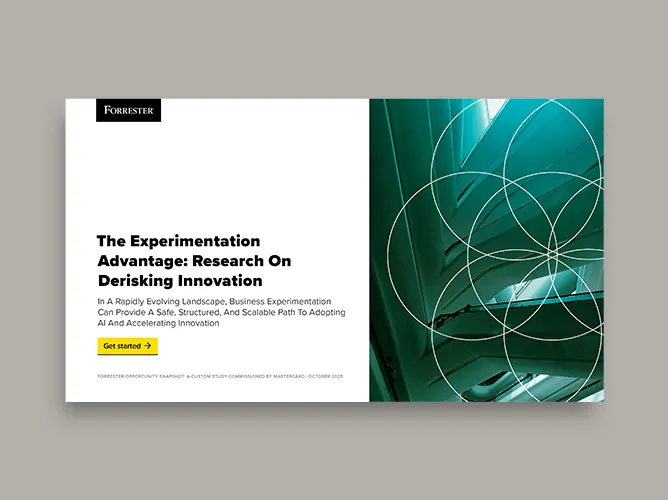By: Rupert Naylor
Published: September 24, 2025 | Updated: October 29, 2025
Read time: 4 minutes
Based on our new white paper, Commerce in Flux: Navigating uncertainty through experimentation.
Customer relationships are the lifeblood of consumer brands – influencing how much time someone spends in a store, whether they click on an ad or what products they put into their shopping cart. In today’s rapidly changing landscape – inflation, turbulent trade dynamics, digital disruption and shifting shopper expectations – customer relationships are more important than ever. To compete, brands can’t afford to rely on old assumptions or stale forecasts.
Rather than commit to major initiatives based on guesswork, businesses are running small-scale experiments to test ideas in the real world. Here are three ways businesses are using experimentation to uncover hidden sources of growth and strengthen their connections to customers.
The right stuff — Optimizing merchandise to suit shifting demand
As customer preferences and supply chain costs fluctuate, brands must determine which products are selling at sustainable levels and prices — and which aren’t. By adding or removing products at a limited number of stores, brands can track shifting customer demands and uncover any unexpected results, such as spikes or dips in the sales of other offerings.
For example, a large convenience store operator replaced some pre-made food items with custom-prepared alternatives in 30 locations. While margins on pre-made food items declined, overall store profitability improved, particularly in low-density areas. Based on these insights, the retailer implemented the changes at similar locations, generating $1.5 million in incremental annual profit.
Takeaway: Test new merchandising strategies before committing to broader rollouts to ensure customer loyalty, basket size and margin are positively impacted.
Location, location, location — Customer loyalty strategy and store realignment
Higher real estate costs, lower margins and rising e-commerce sales are prompting brands to reassess their physical footprints. At the same time, closing a store could alienate customers online as well as offline. For example, a 2025 study of 69 retailers and 2,100 stores showed that, in the weeks after shutting down a physical location, a retailer’s online sales in the area drop nearly 12% on average.1 But rather than relying on averages, leading brands are using business experimentation to drill down deeper and uncover pockets of opportunity.
For instance, one major retailer analyzed the data from past closures, discovering that sales rose by 6% at stores within 15 miles of a closed location. The company used these insights to prioritize its closures, unlocking over $100 million in net present value. Another retailer experimented with offering coupons near a closing location, generating sales for surrounding stores — and demonstrating that targeted communications can mitigate the impact of closing a store.
Despite the continuing growth of e-commerce, physical stores took in three-quarters of global retail sales in 2024, underscoring the importance of an up-to-date brick-and-mortar strategy.2 Brands are experimenting with new store formats, such as micro-stores, dark stores (used only for online order fulfillment) and hybrid fulfillment hubs, using predictive modeling and location-based testing to decide which locations to close or reformat — and where to reinvest.
Takeaway: Using data and in-market experiments to inform storefront strategy can preserve customer loyalty when repositioning a brand’s brick-and-mortar presence.
Getting personal — Tailoring ads for better results
To generate more growth and income, retailers are allowing brands to advertise in their stores and digital properties. These retail media networks (RMNs) are gaining momentum; spending is projected to grow by 8.5% in 2025 as advertisers seek out shoppers ready to buy.3 However, more difficult than counting clicks and views is proving that RMNs deliver the outcomes advertisers want. Two thirds of consumer-goods companies report that they are still figuring out how to maximize the impact of their RMN investments.
Brands can demonstrate value, help advertisers optimize media spend and scale what works using real-world experiments and test-and-control methodology to isolate true campaign lift. In these real-world tests, brands are piloting new RMN formats including shoppable videos, interactive in-store displays and AI-driven personalization that boosts engagement and conversion.
A larger grocer was struggling to measure the effectiveness of its new RMN. The grocer used Mastercard Test & Learn® to isolate and measure advertisers’ performance across various channels, products and customer segments. The test revealed a sixfold increase in incremental return on advertising spend, providing a compelling proof point for advertisers.
Takeaway: Piloting ad strategies on a small-scale helps brands deliver and demonstrate the power of tailored advertising to create a personalized experience for consumers.
Overcoming uncertainty, enhancing customer experiences
Amid shifting market conditions, brands can use experimentation to attract new customers as well as nurture existing customer relationships. By testing the impact of different strategies in real-world conditions, businesses can respond rapidly to shifts in customer behavior, such as shoppers looking for a better product or more value for their spending. In a similar vein, using pilots and data to tailor advertising creates a better shopping experience for consumers and gives brands an opportunity to gain share of voice when competitors are potentially pulling back on marketing.
Mastercard’s solutions help businesses experiment across channels, markets and customer journeys. Whether launching a retail media network, rethinking store strategy or optimizing merchandise, Mastercard helps turn data into direction and uncertainty into opportunity.
To learn more about how brands are using business experimentation to adapt to volatile conditions and make more informed decisions, read our new white paper Commerce in Flux: Navigating uncertainty through experimentation. This piece dives deeper into the themes highlighted above, featuring additional trends, best practices and case studies on how brands are using experimentation to improve strategic decision making.
2“The Outlook For The Retail Industry In 2024 And Beyond.” Forrester. 2024.
3“Impact of Tariffs on US Retail Media Ad Spending.” eMarketer. 2025.











